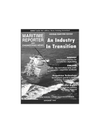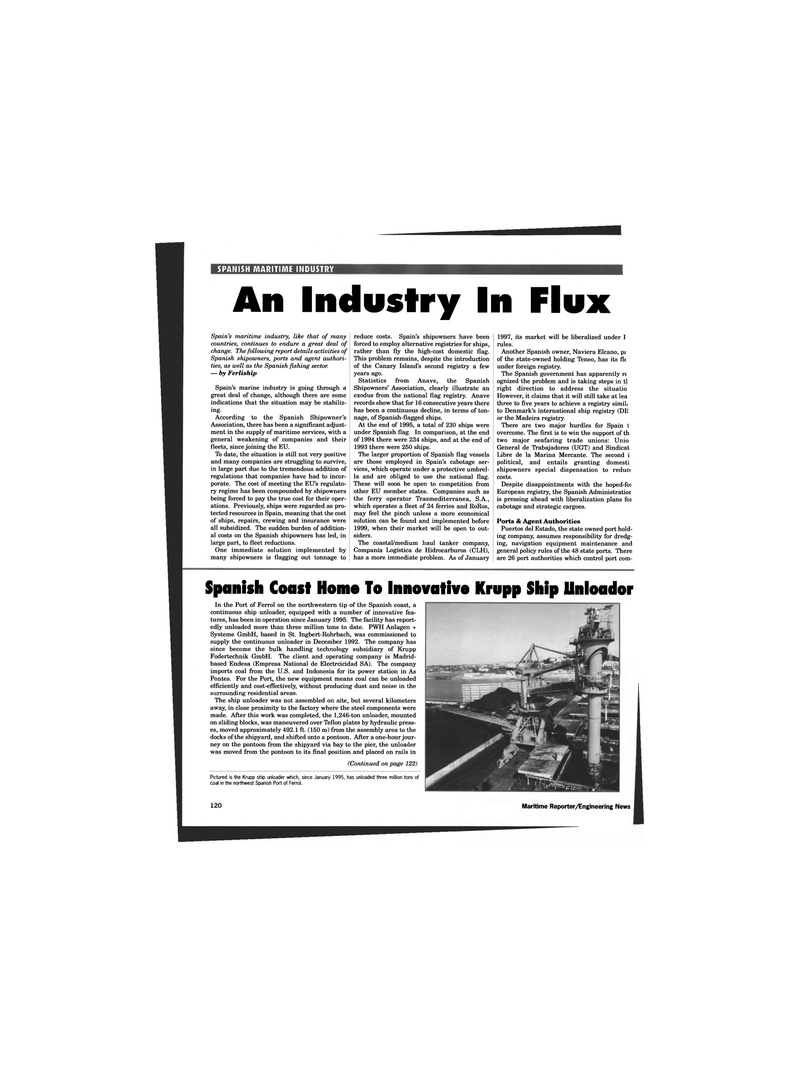
Page 120: of Maritime Reporter Magazine (September 1996)
Read this page in Pdf, Flash or Html5 edition of September 1996 Maritime Reporter Magazine
SPANISH MARITIME INDUSTRY
An Industry In Flux
Spain's maritime industry, like that of many countries, continues to endure a great deal of change. The following report details activities of
Spanish shipowners, ports and agent authori- ties, as well as the Spanish fishing sector. — by Ferliship
Spain's marine industry is going through a great deal of change, although there are some indications that the situation may be stabiliz- ing.
According to the Spanish Shipowner's
Association, there has been a significant adjust- ment in the supply of maritime services, with a general weakening of companies and their fleets, since joining the EU.
To date, the situation is still not very positive and many companies are struggling to survive, in large part due to the tremendous addition of regulations that companies have had to incor- porate. The cost of meeting the EU's regulato- ry regime has been compounded by shipowners being forced to pay the true cost for their oper- ations. Previously, ships were regarded as pro- tected resources in Spain, meaning that the cost of ships, repairs, crewing and insurance were all subsidized. The sudden burden of addition- al costs on the Spanish shipowners has led, in large part, to fleet reductions.
One immediate solution implemented by many shipowners is flagging out tonnage to reduce costs. Spain's shipowners have been forced to employ alternative registries for ships, rather than fly the high-cost domestic flag.
This problem remains, despite the introduction of the Canary Island's second registry a few years ago.
Statistics from Anave, the Spanish
Shipowners' Association, clearly illustrate an exodus from the national flag registry. Anave records show that for 16 consecutive years there has been a continuous decline, in terms of ton- nage, of Spanish-flagged ships.
At the end of 1995, a total of 230 ships were under Spanish flag. In comparison, at the end of 1994 there were 234 ships, and at the end of 1993 there were 250 ships.
The larger proportion of Spanish flag vessels are those employed in Spain's cabotage ser- vices, which operate under a protective umbrel- la and are obliged to use the national flag.
These will soon be open to competition from other EU member states. Companies such as the ferry operator Trasmediterranea, S.A., which operates a fleet of 24 ferries and RoRos, may feel the pinch unless a more economical solution can be found and implemented before 1999, when their market will be open to out- siders.
The coastal/medium haul tanker company,
Compania Loglstica de Hidrocarburos (CLH), has a more immediate problem. As of January 1997, its market will be liberalized under I rules.
Another Spanish owner, Naviera Elcano, pt of the state-owned holding Teneo, has its fie under foreign registry.
The Spanish government has apparently rt ognized the problem and is taking steps in tl right direction to address the situatio
However, it claims that it will still take at lea three to five years to achieve a registry simile to Denmark's international ship registry (DIJ or the Madeira registry.
There are two major hurdles for Spain t overcome. The first is to win the support of th two major seafaring trade unions: Unio
General de Trabajadores (UGT) and Sindicat
Libre de la Marina Mercante. The second i political, and entails granting domesti shipowners special dispensation to reduc< costs.
Despite disappointments with the hoped-foi
European registry, the Spanish Administratior is pressing ahead with liberalization plans for cabotage and strategic cargoes.
Ports & Agent Authorities
Puertos del Estado, the state owned port hold- ing company, assumes responsibility for dredg- ing, navigation equipment maintenance and general policy rules of the 48 state ports. There are 26 port authorities which control port com-
Spanish Coast Home To Innovative Krupp Ship llnloador
Maritime Reporter/Engineering News
Pictured is the Krupp ship unloader which, since January 1995, has unloaded three million tons of coal in the northwest Spanish Port of Ferrol.
In the Port of Ferrol on the northwestern tip of the Spanish coast, a continuous ship unloader, equipped with a number of innovative fea- tures, has been in operation since January 1995. The facility has report- edly unloaded more than three million tons to date. PWH Anlagen +
Systeme GmbH, based in St. Ingbert-Rohrbach, was commissioned to supply the continuous unloader in December 1992. The company has since become the bulk handling technology subsidiary of Krupp
Fodertechnik GmbH. The client and operating company is Madrid- based Endesa (Empresa National de Electrcicidad SA). The company imports coal from the U.S. and Indonesia for its power station in As
Pontes. For the Port, the new equipment means coal can be unloaded efficiently and cost-effectively, without producing dust and noise in the surrounding residential areas.
The ship unloader was not assembled on site, but several kilometers away, in close proximity to the factory where the steel components were made. After this work was completed, the 1,246-ton unloader, mounted on sliding blocks, was maneuvered over Teflon plates by hydraulic press- es, moved approximately 492.1 ft. (150 m) from the assembly area to the docks of the shipyard, and shifted onto a pontoon. After a one-hour jour- ney on the pontoon from the shipyard via bay to the pier, the unloader was moved from the pontoon to its final position and placed on rails in (Continued on page 122)

 119
119

 121
121
